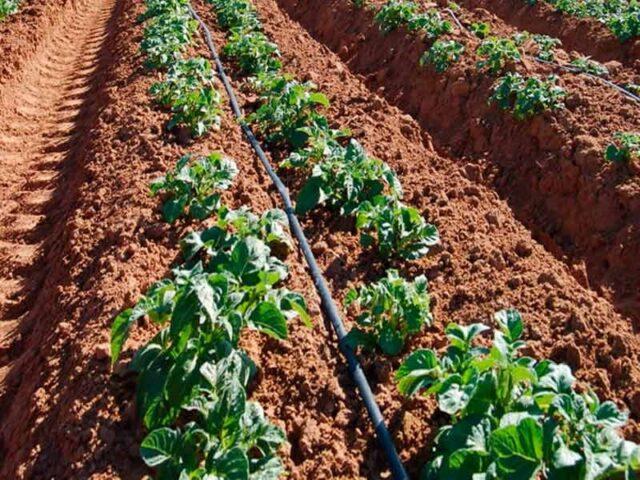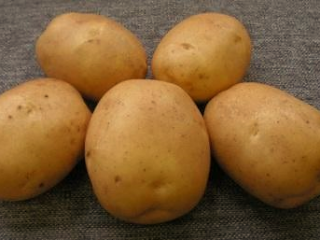Content
Double-row planting of potatoes with wide aisles is one way to increase yields with minimal labor costs. After all, the productivity of a crop depends not only on the correctly selected variety, taking into account the climatic conditions of the region, but also on the area where the plants feed. But the traditional planting method does not always allow for complete hilling of the bushes after the tops are closed, and the pointed ridges prevent moisture from getting into the area where the roots and stolons of the potato are located during rare rains. Therefore, an alternative method of growing is becoming more and more popular every year.

Wide row spacing makes it possible to provide complete care for potato bushes
Advantages of planting potatoes in double ridges
The two-row method has a number of advantages, which is why many gardeners prefer it. However, when using it, you need to be prepared for the frequent use of mineral fertilizers, which is a guarantee of a high yield.

This planting method is suitable for any crop variety
Main advantages:
- saving space;
- Possibility of use on different types of soil;
- there is no need to hill up the bushes and loosen the soil at their base;
- plants are better lit;
- productivity increases by 25%.
More details about growing potatoes in double rows are shown in the video:
A step-by-step method for planting potatoes in double rows
To successfully grow potatoes using this method, you need to choose the right location, prepare the area and planting material. In addition, it is important to follow the planting scheme so that the plants can fully develop and form tubers. Only if all conditions are met, an excellent result is guaranteed.
Site selection
To organize a double bed for planting potatoes, you need to choose a sunny, open place, well lit throughout the day. At the same time, it must be protected from cold gusts of wind. The best option may be the southern or eastern side of the site.
Soil preparation
It is necessary to begin preparing the soil for two-row planting of potatoes in the fall. To do this, you need to dig up the area to the depth of a shovel, remove weeds and carefully level the surface.
Then, using pegs and rope, mark the location of the double rows in a north-south direction. They should have a width of 40 cm, and a distance of 80-110 cm should be maintained between them for good illumination of the plants and quality care. It is recommended to add humus along the entire length of the rows at the rate of 10 kg per 1 sq. m.
In the spring, when the snow has risen and the soil has dried out sufficiently, it is recommended to form ridges 40 cm wide and 12 cm high on the marked rows. After this, you need to add 30 g of nitroammophoska, superphosphate and 25 g of potassium sulfide to the soil, thoroughly mixing the fertilizers with the soil.

At the final stage of preparation, the soil surface must be leveled
Tuber preparation
When using the two-row method of planting potatoes, you must first prepare the tubers. First of all, it is recommended to select large potatoes with a diameter of at least 5 cm. They have a high level of viability, grow quickly and form lush bushes with strong shoots.
20 days before double-row planting, it is necessary to begin germinating tubers. They need to be put in boxes and sprinkled with wet peat, sawdust or humus. The optimal maintenance regime is +15-20 °C. As the soil mixture dries, it must be regularly moistened with a spray bottle.
Scheme for planting potatoes in double rows
Double-row planting of potatoes involves placing bushes in a checkerboard pattern. To simplify the procedure, you need to stretch two parallel ropes along the edges of the ridge. It is necessary to make marks on them in increments of 30 cm with a mixing of 15 cm in relation to each other.
In the designated places you need to make holes 10-12 cm deep. Their diameter should be slightly larger than the size of the tuber. Place a little humus at the bottom of each of them and mix it with the soil. After this, carefully place the sprouted tubers in the holes, pour 1 tbsp on top. l.wood ash and then cover with a layer of earth. After this, the ridges need to be watered generously. And the next day, cover the soil surface with a layer of mulch 5 cm thick. For this, you can use humus, hay or compost.
Care after landing
Caring for potatoes when planting in two rows comes down to timely watering and fertilizing. It is recommended to moisten the ridges when the soil dries 6-8 cm deep. Watering should be carried out not under each bush, but in the center of the strip. Recommended consumption is 10-20 liters per square meter. m, depending on the stage of plant development.
During the season, it is necessary to fertilize potatoes when planting in two rows three times. It is recommended to apply fertilizers for the first time after the emergence of friendly shoots, the second time when the shoots are 15-20 cm high, and the third time during flowering.
To feed potatoes planted in two-row beds, you need to combine:
- 1 kg of potassium sulfate;
- 600 g ammophos;
- 1 kg of urea;
- 400 g dolomite flour;
- 450 g magnesium sulfate;
- 10 g molybdenum compound;
- 25 g of borax.
To fertilize, all components must be thoroughly mixed. After this, you need to make a furrow 5 cm deep in the center of the ridge and pour fertilizer into it, and then cover it with a layer of earth. With subsequent waterings they will dissolve and nourish the plants. Recommended mixture consumption is 40-50 g per 1 sq. m.

At the end of flowering, watering potatoes when planting in two rows should be stopped.
It is also allowed to hill up bushes on both sides of the ridge. This can be done throughout the season. When planting in two rows, the tops inside the ridge close early, suppressing the growth of weeds.This makes it possible to grow potatoes without weeding and loosening the soil.
Conclusion
Two-row planting of potatoes helps to simplify care and increase the productivity of any variety, regardless of the length of its growing season. However, this method gives a good result only if all the rules for its use are followed. After all, not only the two-row planting pattern plays an important role, but also the height and width of the ridge, as well as the distance between the rows. Otherwise, plants will compete for light and nutrition.








